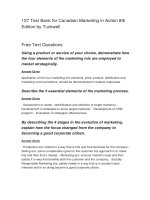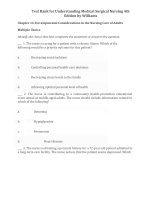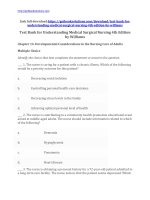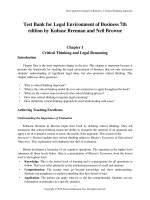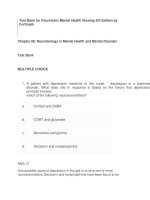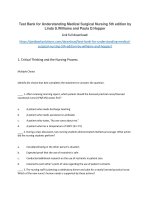Test bank for canadian fundamentals of nursing 4th edition by potter
Bạn đang xem bản rút gọn của tài liệu. Xem và tải ngay bản đầy đủ của tài liệu tại đây (58.01 KB, 7 trang )
buy this full document at
Potter: Canadian Fundamentals of Nursing, 4th Edition
Chapter 1: Health and Wellness
Test Bank
MULTIPLE CHOICE
1. There are different ways to define health and illness. What is the most commonly cited definition
of health?
a. Health is the absence of disease.
b. Health is a function of the physiological state.
c. Health is a state of well-being involving the whole person.
d. Health is the ability to pursue activities of daily living.
ANS: C
The nurse should consider the total person when formulating a definition of “health.” Health is a
positive concept emphasizing social and personal resources, as well as physical capacities.
Health is seen as a resource for everyday living, rather than as the object of living.
Health is considered to be more than merely the absence of disease.
The definition of health has broadened beyond the physiological state to include mental, social,
and spiritual well-being.
An individual who is able to pursue activities of daily living (ADLs) may not define himself or
herself as healthy. Life conditions such as environment, diet, and lifestyle practices may
negatively affect one’s health long before one is unable to perform ADLs.
DIF: Comprehension
REF: 2
2. The population health promotion model aims to develop actions for improving health. In addition
to asking “On what should we take action?” “How should we take action?” and “Why should we
take action?” What is the fourth major question explored by the model?
a. “With whom should we act?”
b. “When should we take action?”
c. “Which government should action?”
d. “Where should we first act?”
ANS: A
The fourth question is With whom should we act?
When should we take action? is not one of the four questions.
Which government should action? is not one of the four questions.
Where should we first act? is not one of the four questions.
DIF: Knowledge
REF: 12 (Figure 1-5)
3. “Health promotion is multisectoral” is a principle of health promotion. What does this principle
mean?
a. Relationships between individual, social, and environmental factors must be
recognized.
buy this full document at
Full file at />b. Physical, mental, social, ecological, cultural, and spiritual aspects of health must
be recognized.
c. In order to change unhealthy living and working conditions, areas other than health
must also be involved.
d. Health promotion uses knowledge from disciplines such as social, economic,
political, environmental, medical, and nursing sciences, as well as from firsthand
experience.
ANS: C
In order to change unhealthy living and working conditions, areas other than health must also
be involved explains the principle, “Health promotion is multisectoral.”
Relationships between individual, social, and environmental factors must be recognized explains
the principle, “Health promotion addresses health issues in context.”
Physical, mental, social, ecological, cultural, and spiritual aspects of health must be recognized
explains the principle, “Health promotion supports a holistic approach.”
Health promotion uses knowledge from disciplines such as social, economic, political,
environmental, medical, and nursing sciences, as well as from firsthand experience explains the
principle, “Health promotion draws on knowledge from a variety of sources.”
DIF: Comprehension
REF: 11
4. What priority strategy for health promotion in Canada is seen as important to incorporate in
nursing education curricula?
a. Knowledge of disease prevention
b. Strategies for health promotion
c. Policy advocacy
d. Concepts of determinants of health
ANS: C
Increasingly, policy advocacy is incorporated into nursing role statements and nursing education
curricula. Nurses should think about policies that have contributed to health problems, policies
that would help to alleviate health problems, and how nursing champions public policies.
Disease prevention is an integral part of nursing curricula.
Health promotion is a fundamental part of nursing curricula.
Nursing curricula integrate determinants of health.
DIF: Comprehension
REF: 11
5. The population health approach emphasizes individual and collective social factors that influence
a population’s health. Which of the following is considered a population-level determinant?
a. Education
b. Personal health practices and coping skills
c. Biology and genetic endowment
d. Income and social status
ANS: A
Education is considered a population-level determinant.
Personal health practices and coping skills are considered an individual-level determinant.
Copyright © 2009 Elsevier Canada, a division of Reed Elsevier Canada, Ltd.
Full file at />Biology and genetic endowment is considered an individual-level determinant.
Income and social status is considered an individual-level determinant.
DIF: Application
REF: 5
6. Which of the following has been identified as the greatest determinant of health affecting
Canadians?
a. Education
b. Health services
c. Social support networks
d. Income and social status
ANS: D
Income and social status is the greatest determinant of health.
Some investigators suggest that literacy and education are important influences on health status
because they affect many other health determinants.
Approximately 25% of a population’s health status is attributed to the quality of its health care
services.
Social support affects health, health behaviours, and health care utilization, but is not the greatest
determinant of health.
DIF: Application
REF: 5
7. A paraplegic client is in the hospital for an electrolyte imbalance. At which level of prevention is
the client receiving care?
a. Primary prevention level
b. Secondary prevention level
c. Tertiary prevention level
d. Health promotion level
ANS: B
The secondary prevention level focuses on early detection of disease once pathogenesis has
occurred, so that prompt treatment can be initiated to halt disease and limit disability.
The primary prevention level focuses on health promotion and specific protection measures such
as immunizations, and the reduction of risk factors such as smoking.
The tertiary prevention level focuses on minimizing residual disability.
Health promotion is a focus of the primary prevention level.
DIF: Application
REF: 10
8. The nurse incorporates levels of prevention as based on client needs and the type of nursing care
provided. Which one of the following nursing activities is an example of tertiary-level preventive
caregiving?
a. Teaching a client how to irrigate a new temporary colostomy
b. Providing a lesson on hygiene for an elementary school class
c. Informing a client that immunizations for her infant are available through the
health department
d. Arranging for a hospice nurse to visit with the family of a client with cancer
Copyright © 2009 Elsevier Canada, a division of Reed Elsevier Canada, Ltd.
Full file at />ANS: D
Tertiary prevention occurs when a defect or disability is permanent and irreversible. At this level,
the hospice nurse aims to help the client and his or her family to achieve a high level of function,
despite the limitations caused by the client’s illness.
Teaching a client how to irrigate a new colostomy would be an example of secondary prevention.
If the colostomy is to be permanent, care may later move to the tertiary level of prevention.
Providing a lesson on hygiene for an elementary school class would be an example of primary
prevention.
Informing a client about available immunizations would be an example of primary prevention.
DIF: Application
REF: 10
9. Since the early 1990s, which group has had the highest amount of absenteeism of all workers in
Canada?
a. “White collar sector” workers
b. Nurses
c. Workers in the trades
d. Transport and equipment operators
ANS: B
There is considerable concern regarding negative workplace conditions in the health care sector.
Nurses have had the highest or second-highest rate of absenteeism of all workers in Canada since
the early 1990s.
Rates of absenteeism for the “white collar sector” were not given.
Rates of absenteeism for workers in the trades were not given.
Rates of absenteeism for transport and equipment operators were not given.
DIF: Application
REF: 7
10. According to research about nutrition in Canada, which one of the following statements is true?
a. Canadians have increased their total fat and salt consumption.
b. Canadians report that their children eat the recommended daily number of fruits
and vegetables.
c. More than half of Canadian children aged 2 to 17 years are overweight or obese.
d. Ten percent of Canadians are overweight or obese.
ANS: A
True. Moreover, one-quarter of Canadians overall, and one-third of teens aged 14 to 18 years,
had eaten at a fast-food outlet the previous day, exposing them to foods high in fats and salts.
False. Seventy percent of children aged 4 to 8 ate fewer than the minimum servings of fruits and
vegetables daily.
False. Twenty-six percent of children aged 2 to 17 years were overweight or obese.
False. In 2001, 56% of men and 39% of women were overweight or obese.
DIF: Application
REF: 8
11. Which of the following is one of the five health promotion strategies identified by the Ottawa
Charter for Health Promotion?
Copyright © 2009 Elsevier Canada, a division of Reed Elsevier Canada, Ltd.
Full file at />a.
b.
c.
d.
Create supportive environments
Strengthen educational opportunities
Develop a medical approach
Minimize stressful situations
ANS: A
Create supportive environments is one of the five broad health promotion strategies identified by
the Ottawa Charter for Health Promotion. These strategies are: building healthy public policy,
creating supportive environments, strengthening community action, developing personal skills,
and reorienting health services.
Strengthen educational opportunities is not one of the five strategies.
Develop a medical approach is not one of the five strategies.
Minimize stressful situations is not one of the five strategies.
DIF: Application
REF: 4
12. Which one of the following is an example of tertiary prevention?
a. Reduction of risk factors, such as smoking
b. Breast self-examination and testicular self-examination
c. Cardiac rehabilitation programs
d. Blood pressure screening to detect hypertension
ANS: C
Tertiary prevention activities occur in the convalescence stage of disease, and are directed toward
minimizing residual disability and helping people to live productively with limitations. An
example is a cardiac rehabilitation program following a myocardial infarction.
Reducing risk factors, such as smoking, is an example of primary prevention.
Breast self-examination and testicular self-examination are examples of secondary prevention.
Blood pressure screening to detect hypertension is an example of secondary prevention.
DIF: Comprehension
REF: 10
13. What is the greatest internal factor for the nurse to consider when educating an adult client
concerning health promotion activities?
a. The client’s emotional wellness
b. The client’s developmental stage
c. The client’s professed spirituality
d. The client’s levels of education and literacy
ANS: D
Levels of education and literacy are important influences to consider when educating an adult
client concerning health promotion activities. Literacy can influence health both directly (e.g.,
medication use, safety practices) as well as indirectly through use of services, lifestyles, income,
work environments, and stress levels.
The client’s degree of stress, depression, or fear, for example, can influence health beliefs and
practices. The manner in which a person handles stress throughout each phase of life will
influence the way he or she reacts to illness. However, this is not the best available option.
Copyright © 2009 Elsevier Canada, a division of Reed Elsevier Canada, Ltd.
Full file at />A person’s thought and behaviour patterns change throughout life. The nurse must consider the
client’s level of growth and development when using his or her health beliefs and practices as a
basis for planning care. In this case, the client has been identified as an adult, and therefore the
developmental stage has been determined.
Spirituality is reflected in how a person lives his or her life, including the values and beliefs
exercised, the relationships established with family and friends, and the ability to find hope and
meaning in life. However, this is not the best available option.
DIF: Analysis
REF: 11
14. Which of the following statements would help the nurse to best discuss the impact of a known
risk factor on a client’s health?
a. “It doesn’t mean that you’ll get the disease, just that the odds are greater for you.”
b. “Now that you know the possibility is there, you can take steps to prevent it.”
c. “This risk factor can be managed by making a change to your lifestyle.”
d. “You’re lucky, because you have the benefit of being able to do something about
it.”
ANS: A
The presence of risk factors does not mean that a disease will develop, but risk factors increase
the chances that the individual will experience a particular disease or dysfunction.
While the statement, “Now that you know the possibility is there, you can take steps to prevent
it” is not incorrect, it does not address the impact of the risk factor on the client’s health.
It is not always true that a risk factor can be managed by making lifestyle changes, and therefore
is not the best available option.
Telling the client that he/she is lucky and has the benefit of being able to do something about a
risk factor minimizes the client’s concern, and does not address the impact of the risk factor on
the client’s health.
DIF: Analysis
REF: 4
15. The nurse is caring for a terminally ill client who recently immigrated to the Canada. To provide
quality end-of-life care, what must the nurse do first?
a. Make every effort to involve the client and his or her family in the end-of-life care.
b. Understand the client’s personal and cultural views regarding death and dying.
c. Arrange for end-of-life care to be provided by health care professionals familiar
with the client’s culture.
d. Share the client’s concerns regarding the dying process with his or her
interdisciplinary care team.
ANS: B
Differences in beliefs, values, and traditional health care practices are relevant when planning
end-of-life care. It is the nurse’s responsibility to become familiar with the client’s personal and
cultural views so as to provide the most effective and appropriate end-of-life care.
While it is important to make every effort to involve the client and his or her family in the endof-life care, it is not the best available option, because understanding the client’s cultural and
personal views will facilitate all other offered options.
Copyright © 2009 Elsevier Canada, a division of Reed Elsevier Canada, Ltd.
Full file at />Arranging for end-of-life care to be provided by health care professionals familiar with the
client’s culture may not always be practical or possible.
While sharing the client’s concerns regarding the dying process with his or her interdisciplinary
care team is important, it is not the best available option, because understanding the client’s
cultural and personal views will facilitate all other offered options.
DIF: Analysis
REF: 10-11
Copyright © 2009 Elsevier Canada, a division of Reed Elsevier Canada, Ltd.
